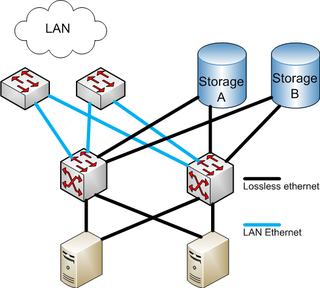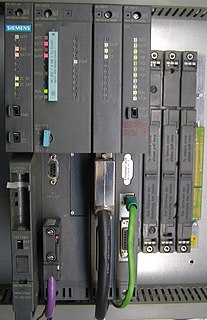AppleTalk is a discontinued proprietary suite of networking protocols developed by Apple Inc. for their Macintosh computers. AppleTalk includes a number of features that allow local area networks to be connected with no prior setup or the need for a centralized router or server of any sort. Connected AppleTalk-equipped systems automatically assign addresses, update the distributed namespace, and configure any required inter-networking routing.

A local area network (LAN) is a computer network that interconnects computers within a limited area such as a residence, school, laboratory, university campus or office building. By contrast, a wide area network (WAN) not only covers a larger geographic distance, but also generally involves leased telecommunication circuits.

Small Computer System Interface is a set of standards for physically connecting and transferring data between computers and peripheral devices. The SCSI standards define commands, protocols, electrical, optical and logical interfaces. SCSI is most commonly used for hard disk drives and tape drives, but it can connect a wide range of other devices, including scanners and CD drives, although not all controllers can handle all devices. The SCSI standard defines command sets for specific peripheral device types; the presence of "unknown" as one of these types means that in theory it can be used as an interface to almost any device, but the standard is highly pragmatic and addressed toward commercial requirements.
The Session Initiation Protocol (SIP) is a signaling protocol used for initiating, maintaining, and terminating real-time sessions that include voice, video and messaging applications. SIP is used for signaling and controlling multimedia communication sessions in applications of Internet telephony for voice and video calls, in private IP telephone systems, in instant messaging over Internet Protocol (IP) networks as well as mobile phone calling over LTE (VoLTE).

Network topology is the arrangement of the elements of a communication network. Network topology can be used to define or describe the arrangement of various types of telecommunication networks, including command and control radio networks, industrial fieldbusses and computer networks.
The Address Resolution Protocol (ARP) is a communication protocol used for discovering the link layer address, such as a MAC address, associated with a given internet layer address, typically an IPv4 address. This mapping is a critical function in the Internet protocol suite. ARP was defined in 1982 by RFC 826, which is Internet Standard STD 37.

LocalTalk is a particular implementation of the physical layer of the AppleTalk networking system from Apple Computer.
Voice over Internet Protocol (VoIP), also called IP telephony, is a method and group of technologies for the delivery of voice communications and multimedia sessions over Internet Protocol (IP) networks, such as the Internet. The terms Internet telephony, broadband telephony, and broadband phone service specifically refer to the provisioning of communications services over the public Internet, rather than via the public switched telephone network (PSTN), also known as plain old telephone service (POTS).
In computing, iSCSI is an acronym for Internet Small Computer Systems Interface, an Internet Protocol (IP)-based storage networking standard for linking data storage facilities. It provides block-level access to storage devices by carrying SCSI commands over a TCP/IP network. iSCSI is used to facilitate data transfers over intranets and to manage storage over long distances. It can be used to transmit data over local area networks (LANs), wide area networks (WANs), or the Internet and can enable location-independent data storage and retrieval.
The Point-to-Point Protocol over Ethernet (PPPoE) is a network protocol for encapsulating PPP frames inside Ethernet frames. It appeared in 1999, in the context of the boom of DSL as the solution for tunneling packets over the DSL connection to the ISP's IP network, and from there to the rest of the Internet. A 2005 networking book noted that "Most DSL providers use PPPoE, which provides authentication, encryption, and compression." Typical use of PPPoE involves leveraging the PPP facilities for authenticating the user with a username and password, predominately via the PAP protocol and less often via CHAP.
The Secure Real-time Transport Protocol (SRTP) is a Real-time Transport Protocol (RTP) profile, intended to provide encryption, message authentication and integrity, and replay attack protection to the RTP data in both unicast and multicast applications. It was developed by a small team of Internet Protocol and cryptographic experts from Cisco and Ericsson. It was first published by the IETF in March 2004 as RFC 3711.

A computer network is a digital telecommunications network which allows nodes to share resources. In computer networks, computing devices exchange data with each other using connections between nodes. These data links are established over cable media such as wires or optic cables, or wireless media such as Wi-Fi.
The Realtek Remote Control Protocol (RRCP), developed by Realtek, is an Application layer protocol, running directly over Ethernet frames. Main idea behind this protocol is to allow direct access to the Ethernet switch controller's internal register over an Ethernet network itself. This approach allows to avoid cost of including a processor, RAM, Flash memory, etc. in a managed Ethernet switch. Instead, all "intelligence" is targeted to reside in a nearby computer, running special RRCP-aware Ethernet switch management software.

Fibre Channel over Ethernet (FCoE) is a computer network technology that encapsulates Fibre Channel frames over Ethernet networks. This allows Fibre Channel to use 10 Gigabit Ethernet networks while preserving the Fibre Channel protocol. The specification was part of the International Committee for Information Technology Standards T11 FC-BB-5 standard published in 2009.
The Stanford University Network, also known as SUN, SUNet or SU-Net is the campus computer network for Stanford University.
Data center bridging (DCB) is a set of enhancements to the Ethernet local area network communication protocol for use in data center environments, in particular for use with clustering and storage area networks.
Ethernet Global Data (EGD) is a protocol that enables producer (server) to share a portion of its memory to all the consumers (clients) at a scheduled periodic rate. This protocol is developed for GE Fanuc PLCs to exchange data between PLCs / GE Drive Systems / GE HMI systems. The protocol uses UDP over Ethernet layers for exchanging the data. A snapshot of internal reference memory, mediated by an Ethernet interface, is referred to as an exchange. An exchange does not require a reply and is identified by a unique combination of three major identifiers.







